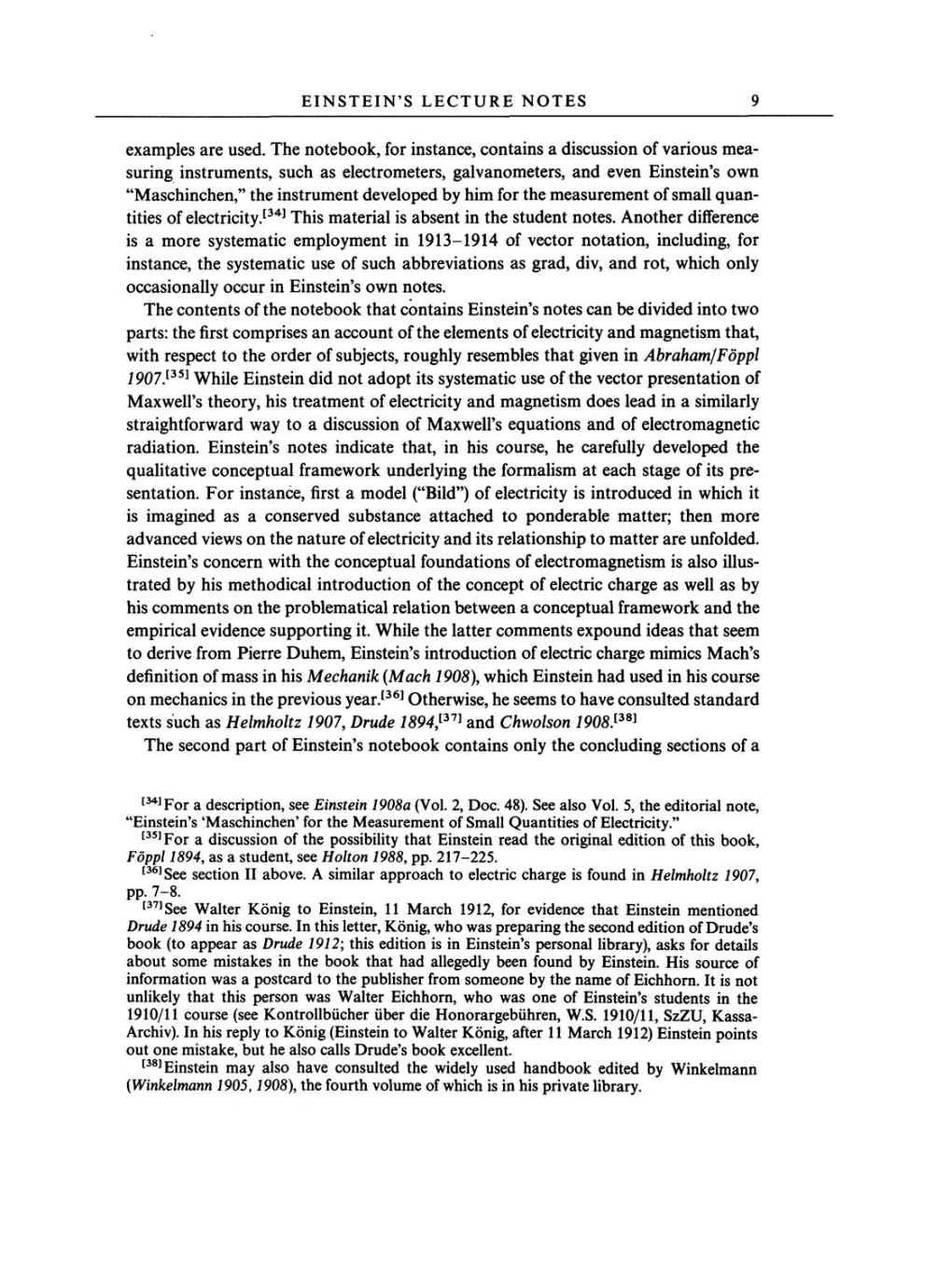EINSTEIN'S LECTURE NOTES
9
examples
are
used.
The
notebook,
for
instance,
contains
a
discussion of various
mea-
suring
instruments,
such
as
electrometers, galvanometers,
and
even
Einstein's
own
"Maschinchen,"
the
instrument
developed by
him for the
measurement
of
small
quan-
tities of
electricity.[34]
This material
is
absent in the student
notes.
Another
difference
is
a more
systematic employment
in
1913-1914 of
vector notation,
including,
for
instance,
the
systematic use
of such abbreviations
as
grad,
div,
and
rot,
which
only
occasionally
occur
in Einstein's
own
notes.
The
contents
of
the
notebook
that
contains Einstein's notes
can
be divided into
two
parts:
the
first
comprises
an
account
of
the
elements
of
electricity
and
magnetism
that,
with
respect
to
the
order of
subjects,
roughly
resembles
that
given
in
Abraham/Föppl
1907.[35]
While Einstein
did
not
adopt
its
systematic use
of
the vector
presentation
of
Maxwell's
theory,
his treatment
of
electricity
and
magnetism
does lead
in
a
similarly
straightforward way
to
a
discussion of Maxwell's
equations
and
of
electromagnetic
radiation. Einstein's
notes
indicate
that, in his
course,
he
carefully
developed
the
qualitative conceptual
framework
underlying
the formalism
at
each
stage
of its
pre-
sentation. For
instance,
first
a
model
("Bild")
of
electricity
is
introduced
in
which
it
is imagined
as a
conserved substance attached
to
ponderable matter;
then
more
advanced
views
on
the
nature
of
electricity
and
its relationship
to matter
are
unfolded.
Einstein's
concern
with the
conceptual
foundations
of
electromagnetism
is also
illus-
trated
by
his methodical
introduction of the
concept
of electric
charge
as
well
as
by
his
comments
on
the
problematical
relation between
a
conceptual
framework and the
empirical
evidence
supporting
it.
While the latter
comments
expound
ideas
that
seem
to derive
from Pierre
Duhem,
Einstein's introduction of
electric
charge
mimics
Mach's
definition of
mass
in
his Mechanik
(Mach
1908),
which Einstein had used
in his
course
on
mechanics in
the
previous
year.[36]
Otherwise, he
seems
to have consulted standard
texts
such
as
Helmholtz
1907,
Drude
1894,[37]
and
Chwolson 1908.[38]
The
second part
of Einstein's
notebook contains
only
the
concluding
sections of
a
[34]For
a
description,
see
Einstein
1908a
(Vol.
2,
Doc.
48).
See
also
Vol.
5,
the
editorial
note,
"Einstein's
'Maschinchen'
for
the Measurement of
Small Quantities
of
Electricity."
[35]For
a
discussion
of the
possibility
that Einstein read the
original
edition of this
book,
Foppl
1894, as a
student,
see
Holton
1988,
pp.
217-225.
[36]See
section II above.
A
similar
approach
to
electric
charge
is
found
in Helmholtz
1907,
pp.
7-8.
[37]See
Walter
König
to Einstein,
11
March
1912,
for
evidence
that
Einstein mentioned
Drude 1894 in
his
course.
In this
letter, König,
who
was
preparing
the second edition of
Drude's
book
(to
appear
as
Drude
1912;
this edition
is in
Einstein's
personal library),
asks for
details
about
some
mistakes in the book
that
had
allegedly
been found
by
Einstein. His
source
of
information
was
a
postcard to
the
publisher
from
someone
by
the
name
of Eichhorn.
It is not
unlikely
that this
person
was
Walter
Eichhorn,
who
was
one
of
Einstein's students
in
the
1910/11
course
(see
Kontrollbücher über die
Honorargebühren,
W.S.
1910/11,
SzZU,
Kassa-
Archiv).
In
his reply to König (Einstein to
Walter
König,
after
11
March
1912)
Einstein
points
out
one
mistake,
but
he
also calls Drude's book
excellent.
[38]Einstein
may
also have consulted the
widely
used handbook
edited
by
Winkelmann
(Winkelmann 1905, 1908),
the fourth volume
of which is in
his
private library.
